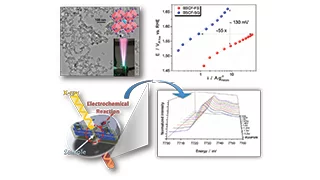Nanoparticle catalysts for extracting hydrogen from water could make renewable energy storage more affordable.
Solar and wind are the top renewable energy sources currently helping to reduce society’s reliance on fossil fuels. However, their capricious nature and availability mean they can meet our needs only when coupled with a reliable way of storing the harvested energy. An increasingly attractive option is to use the generated electricity to split water into hydrogen and oxygen. The hydrogen can then be stored in tanks, transported as needed, and converted back into electricity — with no carbon dioxide emissions.
First performed in 1789, water splitting is now much more efficient thanks to electrocatalysts that accelerate the essential reaction. However, today’s best catalysts — carefully crafted powder compounds — require expensive noble metals such as iridium; cheaper catalysts, such as perovskite oxides made using transition metals, are much less efficient. “Hydrogen is considered the clean fuel of the future,” says Emiliana Fabbri, a senior researcher in the Electrocatalysis and Interfaces group at the Paul Scherrer Institute, “but we are going to need more advanced and affordable catalysts.”
It’s all in the organization
Fabbri led a team from Switzerland and the United States to produce a highly active perovskite catalyst from the relatively common transition metals barium, strontium, cobalt and iron (BSCF). They made their powder using a flame-spray technique for synthesizing nanoparticles, which rapidly heated the metals beyond 1,000 °C and then sprayed them into cold air. The cooling mixture solidified into a highly porous structure of BSCF nanoparticles connected in a random, branch-like arrangement. “This was the first time BSCF had been made as nanoparticles, which provide a very large reactive surface area,” explains Fabbri.
The flame-sprayed catalyst’s surface area was six times that of BSCF powders prepared by the widely used sol-gel method, yet it could handle an electric current 55-times larger for a given voltage — boosting its water-splitting activity. So why the disproportionate improvement? “My chemical intuition was telling me that something was happening to the materials during the reaction,” says Fabbri. Real-time X-ray spectroscopy revealed that the electronic and atomic structure of their perovskite changed as the voltage increased. The atoms’ arrangement became less uniform, and the nanoparticles reassembled into a very active surface layer.
Such structural instability had been assumed to corrode and break down catalysts, so the researchers were surprised to find that it instead improved performance. Indeed, when tested in a commercial electrolyser, their new perovskite even outperformed an iridium-based catalyst.
“Water electrolysers have an essential role in an energy economy based on renewables,” says Fabbri. “The water-splitting reaction is where most efficiency is lost.” Replacing iridium catalysts in industrial electrolysers with flame-sprayed BCSF catalysts would significantly reduce the cost of extracting hydrogen, and help make renewable energy more commercially viable.
Fabbri believes that, with a few improvements, their new catalyst holds much industrial potential. “We want to understand the design principles behind advanced water-splitting catalysts,” Fabbri adds. She has just been awarded a Swiss National Science Foundation grant to fund another five years of research. “This is just the beginning!”
Reference: Fabbri, E. et al. Dynamic surface self-reconstruction is the key of highly active perovskite nano-electrocatalysts for water splitting. Nature Mater. 16, 925–932 (2017). Advanced online publication, 17 July 2017.
Read full article: here


